20 September 2001
V-Loss-ity
Printer
Friendly
We're now looking for a $400 gold price to coincide with our near term objective for Dow 7000.
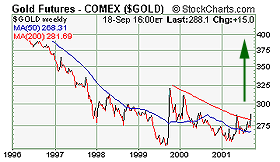 |
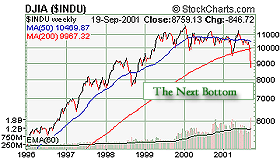 |
| Gold Prices | Dow Industrials |
I'd like to say that it has nothing to do with the catastrophic events of last week, but it wouldn't be 100% true. It is true that we felt the stock market was already on its way to that target, and that the dollar had already broken down in the weeks prior to September 11, but it is also quite clear that the market has suffered a psychological shock whose effect has yet to be fully appreciated.
In the FOMC statement which accompanied Monday morning's interest rate cut, the Fed also acknowledged that "even before the tragic events of last week, employment, production, and business spending remained weak, and last week's events have the potential to damp spending further."
Additionally, the Fed's Beige Book, a bimonthly survey of the US economy, was released on Wednesday (it was prepared prior to Sep 11) and confirmed that consumer spending was already flat to down despite the much anticipated back to school retail demand.
This is not the buying opportunity that Wall Street's cheerleaders swear that it is. For one, nearly every oversold indicator that is referenced assumes a primary bull market. Equities may be lower than they were nine months ago and the Fed Funds rate may have been twice as high, but stocks are not cheaper. On the contrary, the outlook for earnings has deteriorated quicker than multiples have, thus the equity risk premium has yet to rise, which brings us to number two.
Global monetary authorities are quickly depleting their ammunition. The Fed Funds rate, which has been cut from 6.5% to 3% since January 3rd, is already pressuring the acceptable interest rate premium on US dollars over Japanese assets. This we can see in the trouble that the dollar is having against yen on FX markets as of late, which to a degree explains Japan's deflation troubles, and which can precipitate equally difficult inflation problems in the US economy, leading into number three.
The third reason not to buy US stocks is that bond yields are still sticky, and they are going to get stickier. While the Fed Funds rate has declined by more than half, yields on the 10 year note have declined by less than 25 basis points (0.25%), and are thus in conflict with the more dramatic FOMC influence on Equity Risk Preumiums.
Something has got to give. Either the dollar will soar as the US economy discovers itself in the midst of deflation, driving bond yields back down, or the Fed is going to have to start raising interest rates and do what it has done forever - follow the market. We forecast the latter.
On that score, it was perhaps fortuitous that Bill Gross finally got his opportunity to save face, having been painted into a corner by his previously unviable deflation argument.
He was on television Monday evening explaining why he perceived a rising risk to the inflation outlook… though not for about four or so years down the road. Still, I presume that might say something about his confidence for the viability of any "gentleman's agreement" between FX traders. Nevertheless, when he is finished selling his long bonds, his inflation forecasts might shorten to a matter of months, and thus fall more in line with ours.
Henry M. Paulson, Chairman of Goldman Sachs International, also made it on the air this week and wasted no time in reaffirming that the elusive V shaped recovery is about to grab hold of the US economy some time soon.
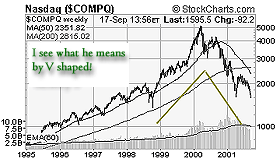 |
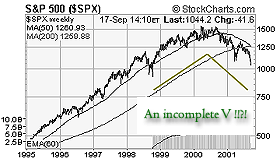 |
| Nasdaq Composite | S&P 500 Index |
However, he neglected to mention the V shaped relapse that the markets have found themselves to still be in the middle of at the moment.
Stock Bulls
of the World Unite!
This week, Europe, Canada, Japan, and belatedly the Bank of England (who
is reported to have actually consedered raising interest rates prior to
Sep 11), joined the FOMC with interest rate reductions that were intended
to provide global capital markets
with enough emergency liquidity to offset the psychological impact of
last week's terrorist attacks on the WTC buildings in New York.
But it's almost sickening to watch bulls spin a rally yarn out of the event. It reminds me of some of the emails we've been getting since the attack, from multi level marketers that seem willing to jump on any excuse to get what they want.
Anyhow, the Bank of Japan started the week off with a currency intervention that was intended to support the dollar against the yen, but when that didn't work, they announced a reduction in the interest rates from 0.25% to a bargain 0.10%, a day before their scheduled meeting. There is little left that they can do to prevent a rise in the FX value of yen (against the dollar) short of direct market operations in the government bond market, in our opinion.
It can be argued that the BOJ intervention did not succeed because it was not at least a coordinated bilateral intervention, which included the almighty Federal Reserve. And were the Fed and ECB to have participated in the effort, undoubtedly there would have been some more follow through.
However, we cannot stress enough that FX interventions are a double-edged sword that can easily undermine the intended outcome if they fail, which they are bound to do under the circumstances. They can only be a confidence tool because most central banks do not have the resources to direct the trend, and if timed poorly, they lose even that edge. Thus, governments are extremely cautious about using them, and the intervention by the BOJ should only underscore the reality - that they have few remaining straws.
The bottom line is that owning dollars just doesn't pay as much as it used to and there be no amount of money that one can forfeit to the patriot cause, which will or should change that truth beyond a glorified brief moment. For many investors, this moment may arrive by Friday. But it is likely to be short lived.
Bond market traders are clearly uneasy with the risks to inflation that can arise from a dollar devaluation, from the current outlook for short-term rates, as well as from the supply implications inherent in the potential for war. Furthermore, if there is one discernable shift in market psychology anywhere, it is that investors have finally let go of the ridiculous budget surplus delusion.
This closure will become increasingly apparent in the days ahead, in our view, as the 30 year US Treasury just broke down out of a small rising wedge that itself came on the heels of an early September break.
The Next
Bottom
None of this of course can be good for the overall stock market, which
has mostly been in a primary bear trend since Fall 2000, and whose only
saving grace has been the benign interest rate environment this summer.
On Monday, the NYSE composite index and the Dow Jones Industrials made
a clear break for new bear market territory. The S&P 500 and the Nasdaq
indexes have been in primary bear market territory for a good year.
These breakdowns preceded the bond market break, and are significant regardless that the terrorist attacks on America are widely (and wrongly) perceived to be the catalyst. And as if to confirm our presumption, in brackets, the breakdown in the Dow Jones Transportation and Utility indexes has actually been lagging the other market averages. In our last report, In Gold We Trust, the bulk of which was prepared prior to September 11, we suggested that all dollar assets should be sold, excepting from that list US gold shares. Nothing has occured since which holds the potential to reverse our conclusion.
Outside of Morgan Stanley's commodity related stocks index, the XAU (gold stocks), the Dow Jones REIT index, and Morgan Stanley's Healthcare indexes, we aren't able to find many more sectors in a primary bull trend. Furthermore, gold stocks are the only stock market sector still in a short term, intermediate, as well as a primary uptrend. As the week has wore on, gold shares have increasingly been the sole survivors.
Forget about the fundamentals. They don't count, and even if they did, the bulls wouldn't be the beneficiaries. The market is expensive, and thanks to the Fed, has not been allowed to discount anything but a V shaped recovery, to date.
Still, we've been debating some kind of bounce here as the corporate buybacks kick in, but there are more than a few obstacles.
One is that the bond market just broke down. Another is that the effort by various media networks to cultivate a patriotic rally is diluted by the reality that they've been crying wolf for way to long. And yet another is that all indications continue for lower profits, contracting economic activity, and as we've noted, the possibility of war. Lastly, even the oversold indicators do not look oversold on the longer term charts.
With all of this, who the heck wants to buy stocks first, particularly at well over 20 times earnings? We certainly don't, unless we're taking profits on a short.
Nonetheless, a market is a market, and a bounce is always possible, and in our view, more so near the end of this week than at any time since late August. The gentlemen's club (in the old days, the stock pool) retired this afternoon to brainstorm a few different ways to skin this cat. According to Bridge.com on September 19th:
With Congress mulling how to jumpstart the U.S. economy, House and Senate leaders this afternoon will receive a closed-door economic briefing from Federal Reserve Chairman Alan Greenspan, National Economic Council Chairman Lawrence Lindsey and former Treasury Secretary Robert Rubin. U.S. Treasury Secretary Paul ONeill may also attend the briefing. Greenspan and other financial experts will give their opinions on an economic stimulus package. Proposals include payroll tax deductions, changes in the depreciation rate for businesses, investment tax credits, changes in the alternative minimum tax and a possible reduction in the capital gains tax.
To the extent that the (paper) bulls can maintain any hegemony over this psychology, it is possible that there may be one more attempt to rally this market before it gives way to our 7000 target. But possible does not mean likely. On the contrary, in all likelihood, we're on our way to the next bottom in this enduring bear market, at 7000, without anything more than a hiccup.
Whatever you do, remember that the trend is your friend, and that the greatest protection from the effects of a clearly rising trend in the volatility of paper assets and rhetoric, is in gold. At under $300 an ounce, that is cheap.
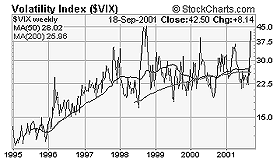 |
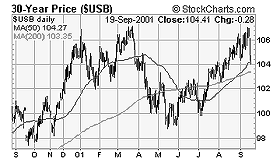 |
| Volatility Index - VIX / 1995 -2001 | US Treasury Bond (1 year chart) |
Good
Luck,
Ed
Bugos
Editor
The Goldenbar Report: is not a registered advisory service and does not give investment advice. Our comments are an expression of opinion only and should not be construed in any manner whatsoever as recommendations to buy or sell a stock, option, future, bond, commodity or any other financial instrument at any time. While we believe our statements to be true, they always depend on the reliability of our own credible sources. Of course, we recommend that you consult with a qualified investment advisor, one licensed by appropriate regulatory agencies in your legal jurisdiction, before making any investment decisions, and barring that, we encourage you toconfirm the facts on your own before making important investment commitments.